http://www.osengines.com/motors/index.html By Ken Myers April 2012 Updated with new data April 24, 2012 Updated Nov. 25, 2012 Tower Hobbies nomenclature: O.S. .30 2-Stroke Brushless Motor ($79.99US as of September 2011 - price drop, April 2012 $74.98US)
I purchased the O.S. Motor OMA-3825-750 brushless outrunner motor for a "club trainer" project. I found the fit and finish of the outrunner motor to be very nice. I do not take my motors apart when testing them, so I have no comments about the actual construction. The OMA 3825-750 performed well through the remainder of the 2011 flying season and continues to perform well this year using a 4S1P "A123" 2300mAh battery pack and APC 12x8E prop. The "club trainer", a Thunder Tiger Lazy Tiger Cub, has about 675 sq.in. wing area and weighs 3.97 lb./63.5 oz. and uses a 4S1P "A123" 2300mAh pack. I have a lot of experience with 4S "A123" 2300mAh power systems. I use a Scorpion SII-3026-710 (3852-815, 205g) on a 4S "A123" 2300mAh in the Super Stearman. The Super Stearman uses an APC 13x8E prop and initially draws about 35 amps at 11.43 volts for about 400 watts in. The OMA-3825-750, whose generic name (can diameter mm, can length mm dash Kv, wt. in grams) is an O.S. 3848-750, 190g, according to the manufacturer's specifications, looked like a good choice for the trainer. Using the generic naming demonstrates that these are quite similar motors by the outside dimensions of diameter and length, Kv and weight. Comment added Nov. 25, 2012
Scorpion 3852-770, 204g
Unfortunately, the Scorpion line of outrunners has passed my perceived value price point due to substantial price increases. That is why I purchased my first O.S. OMA-3825-750. It was less expensive than the equivalent motor from Innov8tive Designs for either the Scorpion or Cobra lines. While the information provided by O.S. Motor, and therefore Tower Hobbies, proved to be inaccurate, I have never found a problem with service from Tower Hobbies. When I took the price and service into consideration, the O.S. Motor brand seemed to be a decent value. I am a member of the Tower Hobbies Super Saver club. Members of the Tower Hobbies Super Saver Club are often offered free standard shipping with a minimum purchase of $99 and with the purchase of $100 or more about a 15% discount when using a certain Ad Number Code. If I'd purchased it in April 2012 with other items, it is possible to have gotten the motor for about $53.74 delivered, which is a perceived good value to me. Weights & Measures: Outside diameter: 37.5mm/1.48 in.
Castle Creations Phoenix Ice 50 ESC (timing set to Low/0-deg)
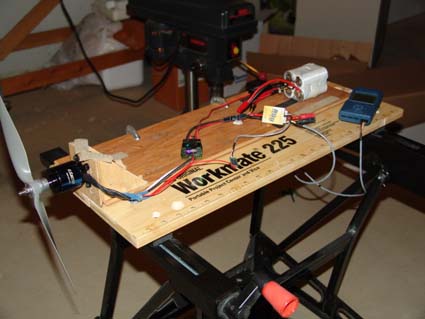
Photo of testing setup Other Important Specifications from the O.S. Motor Instruction Sheet Poles: 14
Motor weight/no prop adapter: 192.8/6.8 oz.
This example appears to have a significantly higher Kv than what was stated by O.S. Motor, 750Kv. A fully charged 4S "A123" 2300mAh pack was used, without recharging, for all of the data gathering, except for one no load test that was done with a 3S "A123" 2300 pack. The ESC was set to Low/0-deg timing. An Emeter II was used to gather all the data, NOT the onboard data from the Castle Creations Phoenix Ice 50 amp ESC.
After all of the data was input into Drive Calculator, a test using an APC 12x8E thin electric prop was completed at what I call 'take off' power. Approximately 5 seconds into the run of a fully charged 4S "A123" 2300mAh pack the numbers were; 11.77 volts, 33.8 amps, 397.8 watts in and 7920 RPM. With the 12x8 APC E default prop in Drive Calculator and the voltage set to Constant voltage 11.77 the Drive Calculator estimate is 33.6 amps, 395.9 watts in and 7,765 RPM. |
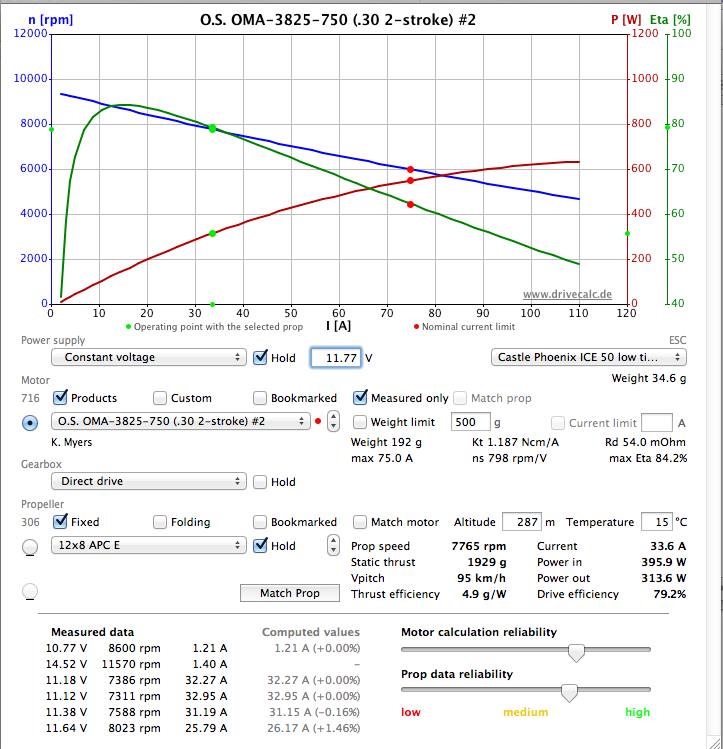
| The only significant difference I found from the O.S. Motor specifications is the Kv. The drill press method (805 Kv) and Drive Calculator's Kv, 804.2, found on the motor page, indicates a Kv of about 805. I am satisfied to note the Kv is 805, rather than the stated 750.
With the new weight and Kv, the generic motor name is now O.S. 3848-805,193g Motor testing spreadsheet available at theampeer.org
A screen capture of the Drive Calculator motor input data follows and shows the Drive Calculator calculated Kv of 804.2. |

| O.S. Motor notes the Watts as 590 for this motor.
www.osengines.com/motors/index.html 590 watts in / 192.8g = 3.06 watts in per gram of motor weight. I tend to use motors in this weight class for 350 watts in to 500 watts in applications. Those who do "burst flying" such as 3D or Limited Motor Run (LMR) might feel comfortable using the motor at 192.8 * 4.5 watts in/g = 868 watts in, but since I don't do those types of flying, I cannot recommend it. There is a problem with the Propeller Data Chart for the OMA-3825-750 as presented in the Owner's Instruction Sheet. I've reproduced the chart along with a chart for the Drive Calculator's predictions. The voltages in Drive Calculator's predictions are based on 3.7 volts per cell. That is about the voltage per cell, after the first 15 seconds of so at maximum power of a decent Li-Poly battery of the correct C rating. |
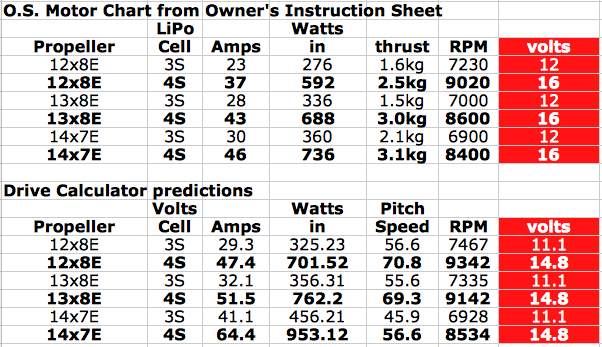
These are the original numbers in the single page Instruction Manual and posted originally.
They have been changed! See Addendum
| When looking at the prop charts, it is important to remember that O.S. rates this motor to about 40 amps.
I do not have any Li-Poly packs to actually verify the numbers in the Drive Calculator calculated chart, but they should be fairly close. As O.S. Motor says in the manual, "Be sure to measure the current value with a measuring instrument." Take the Drive Calculator chart with a 'grain of salt', but then again, I find the O.S. Motor numbers extremely questionable! www.rcgroups.com/forums/showpost.php?p=19800562&postcount=125 4000mAh 20C 3S, 13X6.5 APC E prop on the .30 size OS Brushless.
It looks like the Drive Calculator predictions are fairly close. Arthur Deane loaned me a fully charged 4S 4000mAh Li-Poly battery. I took readings with the Emeter II, as I was curious as to what the amp draw would be. O.S. Motor said it would be 37 amps with an APC 12x8E prop using a 4S LiPo. The Emeter II indicated; 15.37v, 56.3 amps, 865 watts in at 9,582 RPM. With 15.37v and an APC 12x8E prop, Drive Calculator predicted; 52.6 amps, 809 watts in and 9,497 RPM. |
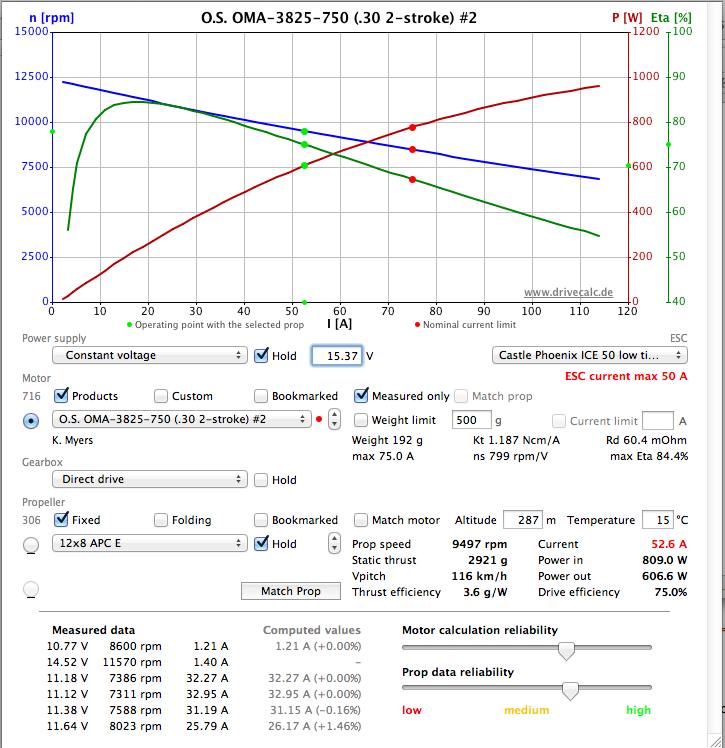
| More discussion about 'how wrong' the supplied prop data is on the O.S. Motor instruction sheet can be found starting here: www.rcgroups.com/forums/showthread.php?t=1490120&page=3
Also see: www.rcgroups.com/forums/showpost.php?p=19551372&postcount=82 From all outside appearances this O.S. Motor outrunner seems to be decently produced. The example that I tested ran smoothly both with and without a prop load. My perceived value is fair because O.S. Engines and Tower Hobbies stand behind them. The biggest drawback is that the end user needs to gather the important motor parameters to select the appropriate propellers that will not "overload" the motor. The recommended propellers are just "wrong" for keeping the motor within the stated amp limits for sport flying! I am looking forward to many more years of flights on this motor. RC Groups' member, Skylar, has posted some slightly different data in this post.
He found the Kv to be 794 with his drill press test. His data reports slightly less amps and watts in when using the same props in the Drive Calculator predictions I posted here. They are still higher than O.S. states on their instruction sheet. O.S. data sheet: 12x8E 4S 16v, 37A, 592 watts in, 9020 RPM
The results differences between DC and Skylar can partially be explained by the higher Kv that I measured. There are variances in the manufacturing process that may also contribute the differences between DC and Skylar's testing. At this time, I need more actual user collected data to verify the Drive Calculator predictions, although data from Mahu, www.rcgroups.com/forums/showpost.php?p=19800562&postcount=125, seems very similar to the Drive Calculator predictions. 4000mAh 20C 3S, 13X6.5 APC E prop on the .30 size OS Brushless.
While revising this article on Nov. 25, 2012, I discovered a whole new set of prop data had been posted for this motor. 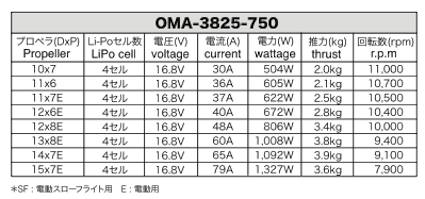
Manual 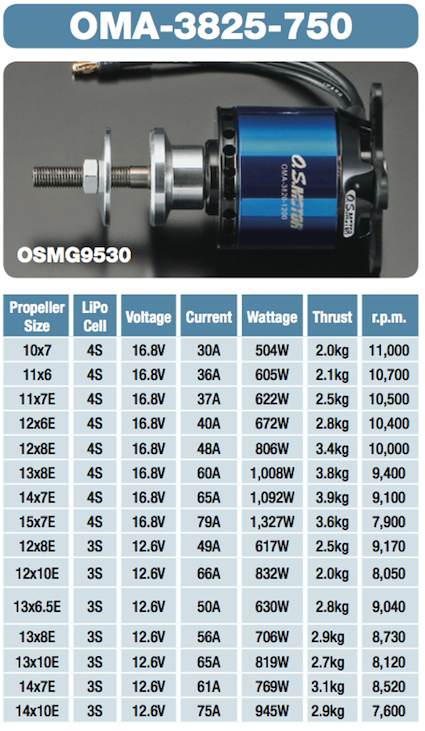
Web site spec page 12.6V for a 3S LiPo and 16.8V for a 4S LiPo is an unusual voltage to test at. All of the RPM numbers have been rounded to the nearest 100 RPM for the 16.8V tests. Tested at flying field: 12x8E, 15.37v, 56.3 amps, 865 watts in at 9,582 RPM. Skylar: 12x8E, 4S 14.94v, 44.4A, 663 watts in, 9330 RPM at 1330m elevation
Table numbers for 4S 12x8E, 16.8V, 48A, 806W, 10,000 rpm
Besides the 'real world' numbers not matching the prop performance table very well, there is a 'glaring' error in the prop performance test table. 12x8E 4S 16.8V 48A 806W 3.4Kg 10000 rpm
If the 12x8E is drawing 48 amps at 16.8V it MUST be drawing less amps at 12.6V. The prop performance table shows it drawing more, 49 amps. From the prop performance table;
From reported 'real world' data:
There are 15 examples given in the prop performance table. Only four of the fifteen are 40 amps or lower. The motor is rated by O.S. Motor at 40 amps. |